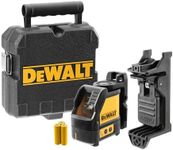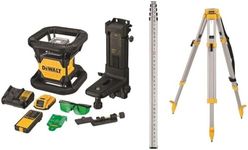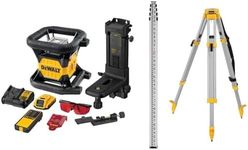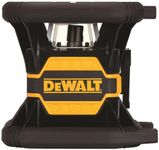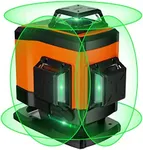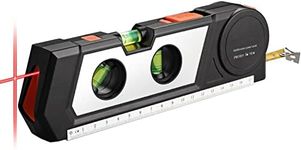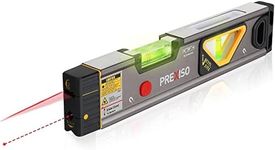Buying Guide for the Best Self Leveling DeWalt Lasers
When choosing a self-leveling laser, it's important to consider the specific needs of your projects. Self-leveling lasers are essential tools for ensuring accuracy in construction, carpentry, and various DIY tasks. They help you achieve perfectly straight lines and level surfaces with minimal effort. To pick the best self-leveling laser for you, focus on the key specifications that will impact its performance and suitability for your tasks.AccuracyAccuracy refers to how close the laser's level line is to true level. This is crucial because even a small deviation can lead to significant errors in your project. Accuracy is usually measured in millimeters per meter (mm/m) or inches per foot (in/ft). Higher accuracy (e.g., ±1/8 inch at 30 feet) is better for precision tasks like cabinetry or tile work, while slightly lower accuracy (e.g., ±1/4 inch at 30 feet) might be sufficient for general construction.
RangeRange is the maximum distance the laser can project a visible line. This is important for larger projects where you need to cover more ground. Ranges can vary from around 30 feet to over 100 feet. For indoor tasks or small rooms, a shorter range is adequate. For outdoor projects or large spaces, look for a laser with a longer range to ensure visibility and effectiveness.
Self-Leveling RangeSelf-leveling range indicates the degree to which the laser can adjust itself to find level. This is important because it determines how much you need to manually adjust the device. A typical self-leveling range is around ±4 degrees. If you often work on uneven surfaces, a larger self-leveling range can save you time and effort.
Beam TypeBeam type refers to the pattern of the laser projection, such as a single line, cross line, or 360-degree line. This is important because different tasks require different beam types. Single lines are good for basic leveling, cross lines are useful for aligning both horizontal and vertical planes, and 360-degree lines are ideal for full-room layouts. Choose the beam type based on the complexity and nature of your projects.
DurabilityDurability encompasses the build quality and resistance to dust, water, and impacts. This is crucial for ensuring the longevity of your tool, especially in harsh working environments. Look for lasers with a high IP rating (e.g., IP54 or higher) for better protection. If you work in tough conditions, prioritize a more rugged and durable model.
Battery LifeBattery life indicates how long the laser can operate on a single charge or set of batteries. This is important for uninterrupted work, especially on longer projects. Battery life can range from a few hours to over 20 hours. Consider how long your typical work sessions are and choose a laser with sufficient battery life to avoid frequent recharging or battery changes.
Mounting OptionsMounting options refer to the ways you can set up the laser, such as with a tripod, wall mount, or magnetic base. This is important for versatility and ease of use in different scenarios. If you need to frequently reposition the laser or work on various surfaces, look for models with multiple mounting options to enhance flexibility and convenience.
